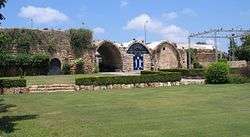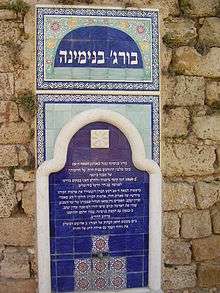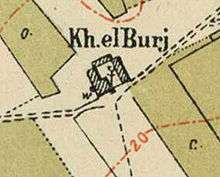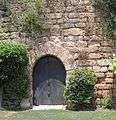Khirbat Al-Burj
Khirbat Al-Burj was a former Palestinian village, depopulated in 1948.[2] Presently, Khirbat Al-Burj (lit. "ruin of the tower") or Burj Binyamina is a ruined stone-built structure in the Sharon Plain 1 km south of Binyamina from the Ottoman period, situated at a crossroads and believed to be either a mansion connected to an estate, a fortified farmhouse, or a khan (caravanserai).[3]
Khirbat Al-Burj Burj Binyamina | |
|---|---|
Village | |
 | |
| Etymology: "The tower" in Arabic[1] | |
.jpg) .jpg) .jpg) .jpg) A series of historical maps of the area around Khirbat Al-Burj (click the buttons) | |
 Khirbat Al-Burj Location within Mandatory Palestine | |
| Coordinates: 32°30′35″N 34°56′28″E | |
| Palestine grid | 144/212 |
| Geopolitical entity | Mandatory Palestine |
| Subdistrict | Haifa |
| Current Localities | Binyamina |
History
Byzantine period
During June 2009, archeological excavations in the courtyard of the Burj building from the Ottoman period exposed a small building that dated to the Byzantine period (5th–7th centuries CE).[3] Byzantine ceramics have been found at the structure.[4]
Crusader period

A stone with Greek inscription was found at the burj site, which has been reused in a Crusader fortress.[4]
Late Ottoman and Mandate periods
In 1882, the PEF's Survey of Western Palestine (SWP), which called it Burj el Kheil, described it as "A Baikeh or cattle-yard in the plain."[5]
Schumacher found in 1887 that the site had been settled since the PEF map was prepared, now consisting of "12 huts, moderate village".[6] A population list from about 1887 give for that place, called Burj el Kheil, about 105 inhabitants; all Muslims.[7]
On October 26, 1898, German Kaiser Wilhelm II stayed at the Burj khan (caravanserai) building during his visit to the Holy Land.[3]
Early Zionist activity
Turkish owner, Sidki Pasha, brother of Jamal Pasha, sold 4,000 dunams of the Burj farmland to ICA in 1903.[8] The serious drawback was that most of the land was an uncultivable swamp.[9] Rothschild turned the land over to Binyamina's holdings.[9] Initially a group of farmers from Zichron Ya'akov stayed at the khan during the week, due to the distance to their hometown. The group was called Burja’im.[3]
Binyamina (1922)
Subsequently, Binyamina was founded.[3] A letter from early 1920s describes establishment of Binyamina: "The 'Zichronim' [people of Zichron Ya'akov] owners of Burj farm decided to establish a moshavah in this farm, in order to settle their sons there… "[10]

Burj became Binyamina in 1922.[8] In the 1931 census Khirbat Al-Burj was listed under Binyamina.[11] The ownership of the village land was determined in 1934 according to the Land Settlement Ordinances.[12]
By the time of the 1945 village survey, there were 5,291 dunums, 15 of which were owned by Arabs, 4,933 owned by Jews, and 343 were public.[13][14]
The building, after renovations, now operates as an event venue.[15]
Arab population issue
In the 1945 Index Gazetteer, Khirbat Al-Burj was listed as a "village unit" but "no population".[16] According to Frantzman, the 1:20,000 map (produced 1924-1948) shows "a large structure, akin to a khan with no indication that it was populated".[16] According to Khalidi, Khirbat Al-Burj was a Palestinian village which was depopulated by Israelis in 1948.[2] Khalidi also says the "village" was "known for its citrus crops" and situated on "rolling terrain".[16]
Agriculture
The red sandy clay loam (hamra) soils from Binyamina to Gedera, west of the coastal plain, were not cultivated till the 20th century.[17] The original economy of Binyamina was citrus-based.[18]
Gallery
See also
References
- Palmer, 1881, p. 146
- Khalidi, 1992, p. 156
- Masarwa, 2011, Benyamina, Burj Benyamina
- Dauphin, 1998, p. 744
- Conder and Kitchener, 1882, SWP II, p. 52
- Schumacher, 1887a, p. 84
- Schumacher, 1887b, p. 178
- Ramat Hanadiv excavations: final report of the 1984-1998 seasons, by Yizhar Hirschfeld, Adrian J. Boas, p. 664
- Avneri, 1984, p. 107
- Document Regarding the Establishment of Binyamina, early 1920s
- Mills, 1932, p. 88
- Government of Palestine, The Palestine Gazette, Supplement 2 to Issue 475, 8 November 1934, p. 953.
- Government of Palestine, Department of Statistics. Village Statistics, April, 1945. Quoted in Hadawi, 1970, p. 48
- Government of Palestine, Department of Statistics, 1945, p. 14
- https://www.burge-binyamina.com/en/ Burge Binyamina Event Venue]
- "The Arab settlement of Late Ottoman and Mandatory Palestine: New Village Formation and Settlement Fixation, 1871-1948", Seth J. Frantzman, pp.71-72
- The Jewish people in the first century: historical geography, political history, social, cultural and religious life and institutions. Vol. 2, by Samuel Safrai; M Stern, page 640
- Jewish National Fund (1949). Jewish Villages in Israel. Jerusalem: Hamadpis Liphshitz Press. p. 24.
- Survey of Palestine, map Caesarea 1:20,000, 1942. map 14-21.1942
Bibliography
- Avneri, Arieh L. (1984). The Claim of Dispossession: Jewish Land-settlement and the Arabs, 1878-1948. Transaction Publishers. ISBN 0-87855-964-7.
- Conder, C.R.; Kitchener, H.H. (1882). The Survey of Western Palestine: Memoirs of the Topography, Orography, Hydrography, and Archaeology. 2. London: Committee of the Palestine Exploration Fund.
- Dauphin, Claudine (1998). La Palestine byzantine, Peuplement et Populations. BAR International Series 726 (in French). III: Catalogue. Oxford: Archeopress. ISBN 0-860549-05-4.
- Government of Palestine, Department of Statistics (1945). Village Statistics, April, 1945.
- Hadawi, S. (1970). Village Statistics of 1945: A Classification of Land and Area ownership in Palestine. Palestine Liberation Organization Research Center.
- Khalidi, W. (1992). All That Remains: The Palestinian Villages Occupied and Depopulated by Israel in 1948. Washington D.C.: Institute for Palestine Studies. ISBN 0-88728-224-5.
- Masarwa, Durar (2011-08-18). "Benyamina, Burj Benyamina" (123). Hadashot Arkheologiyot – Excavations and Surveys in Israel. Cite journal requires
|journal=(help) - Mills, E., ed. (1932). Census of Palestine 1931. Population of Villages, Towns and Administrative Areas. Jerusalem: Government of Palestine.
- Palmer, E.H. (1881). The Survey of Western Palestine: Arabic and English Name Lists Collected During the Survey by Lieutenants Conder and Kitchener, R. E. Transliterated and Explained by E.H. Palmer. Committee of the Palestine Exploration Fund.
- Schumacher, G. (1887a). "Researches in the plain north of Caesarea". Quarterly statement - Palestine Exploration Fund. 19: 95–84.
- Schumacher, G. (1887b). "Population list of the Liwa of Akka". Quarterly statement - Palestine Exploration Fund. 19: 169–191.
External links
- Welcome To al-Burj, Khirbat
- Khirbat al-Burj (Haifa), Zochrot
- Survey of Western Palestine, Map 8: IAA, Wikimedia commons


